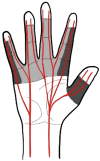The NEON (Nerve rEpair Or Not) trial: a randomized controlled trial of microsurgical repair versus nerve alignment for digital nerve injury
- PMID: 40905509
- PMCID: PMC12409716
- DOI: 10.1093/bjs/znaf174
The NEON (Nerve rEpair Or Not) trial: a randomized controlled trial of microsurgical repair versus nerve alignment for digital nerve injury
Abstract
Background: Digital nerves provide sensibility to the fingers. They are commonly injured through accidental sharp laceration. The aim of the NEON (Nerve rEpair Or Not) study was to investigate whether microsurgical suture repair of lacerated digital nerves is superior to nerve alignment alone without suture repair.
Methods: A two-arm, parallel group, double-blind, multicentre RCT was undertaken over 2 years. Participants with suspected unilateral digital nerve injury underwent surgical exploration and were randomized to microsurgical suture repair or nerve alignment alone. The primary outcome was the Impact of Hand Nerve Disorders (I-HaND v2) patient-reported outcome measure (PROM) at 12 months post-randomization. Secondary outcomes assessed were: objective neurosensory and functional recovery; health-related quality of life to examine cost-effectiveness; complications of surgery and clinically problematic neuroma rates (Elliot score). Both participants and assessors were blind to allocation.
Results: A total of 122 adults were randomized to microsurgical suture repair (n = 61) or nerve alignment alone (n = 61). Primary outcome data using the I-HaND (v2) were available for 106 participants (87%) at 12 months. There were no statistically significant differences in I-HaND scores at all time points, including the 12-month primary end point (15.9 versus 20.2, P = 0.09; 95% c.i. [-0.9, 10.8]). There were also no differences in all secondary outcome measures, including Patient Evaluation Measure and EQ-5D-5L scores at 12 months. Complications were similar at 6 weeks and 12 months. The trial was closed early by the funder owing to slow recruitment and did not reach the intended sample size.
Conclusion: Based on the available data from the NEON trial, there is no evidence to support the beneficial effect of suture repair over nerve alignment alone for isolated digital nerve injury. This multicentre RCT can be used to inform future trials, inform patients and guide clinical practice.
Funding: NIHR Health Technology Assessment (NIHR127807-18/37).
Trial registration number: ISRCTN16211574.
© The Author(s) 2025. Published by Oxford University Press on behalf of BJS Foundation Ltd.
Figures
References
-
- Manley OWG, Wormald JCR, Furniss D. The changing shape of hand trauma: an analysis of Hospital Episode Statistics in England. J Hand Surg Eur 2019;44:532–536 - PubMed
Publication types
MeSH terms
Grants and funding
LinkOut - more resources
Full Text Sources
Medical




